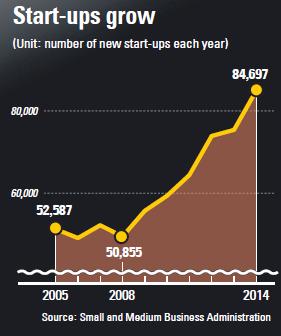Korea’s start-ups have worst success records

A report published by the Institute for International Trade under the Korea International Trade Association (KITA) on Monday said that the number of start-ups has steadily increased in Korea, but the sustainability of their businesses is still low.
According to data compiled by the Small and Midsize Business Administration (SMBA), Korea had about 85,000 new start-ups in 2014, a 64 percent jump from 52,000 in 2005.
Some of the growth is attributable to the Park Geun-hye administration’s creative economy initiative, which aims to make start-ups a key pillar of the nation’s economy. It expanded government subsidies for start-ups through economy innovation centers and government-led start-up funds. The central government’s budget to support start-ups rose from 1.4 trillion won ($1.3 billion) in 2013 to 1.5 trillion won in 2014 and 1.54 trillion won this year.
However, 59 percent of Korean start-ups close their doors after three years and nearly 75 percent close within five years. Only 8 percent of Korean start-ups stayed in business for 10 years or more.
When the report compared the flame-out rate of early-stage start-ups in 17 Organization for Economic Cooperation and Development (OECD) countries, Korea was at the lowest level.

The KITA report said this is because nearly 63 percent of all Korean start-ups do business in less-than-dynamic areas like lodging, eateries and retail. Most start-ups are run by a person who has quit or retired from a career. Technology-oriented, value-added businesses account for only 21 percent of all Korean start-ups.
In Israel, only 13 percent are in such areas, and in Japan the figure is 22 percent. Nearly 58 percent of all Israeli start-ups were technology-oriented, while in Japan the figure was 46 percent.
The next aim of Korea’s technology industry should be to overcome the so-called Death Valley, which refers to start-ups’ struggles between their third and seventh year, which is when they often run out of cash, the report said.

According to the Korea Venture Capital Association, start-ups that are at least seven years old receive the most investment from local venture capital firms.
The KITA report said early to mid-stage start-ups should continue allocating heavy amounts for R&D, exploring new businesses and management systems which are crucial factors for survival.
Kim Bo-kyung, researcher at the corporate competitiveness department at KITA’s trade institute, emphasized the government should keep its funding more balanced in order to help existing start-ups continue to expand.
“The government should change its assessment standards to expand funding to start-ups with bright technology prospects,” said Kim. “It also should expand funding to failed start-ups, so that more entrepreneurs start anew with insights gained from past failures.”
BY KIM JI-YOON [kim.jiyoon@joongang.co.kr]










with the Korea JoongAng Daily
To write comments, please log in to one of the accounts.
Standards Board Policy (0/250자)